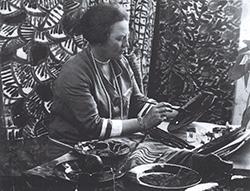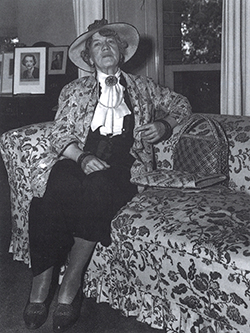A PRIVATE COLLECTION OF WORKS BY KATHLEEN O’CONNOR LOTS 35 – 41
A Private Collection of Works by Kathleen O’Connor
KATE O'CONNOR INTRO 1.jpg

KATHLEEN O’CONNOR PAINTING
PLATES AND FABRICS AT
DAVID JONES, SYDNEY, 1927
Kathleen (Kate) O’Connor was one of that significant generation of Australian women artists who were drawn to study at international art centres in the early decades of the twentieth century. Whilst most would return after a few years, O’Connor made France and England her home for almost fifty years before disillusion and bouts of ill health forced her unwilling return to these shores at the age of seventy-nine. Even so, her remaining thirteen years were filled with continuous activity, including exhibitions, awards and her second official Retrospective in 1967, the year prior to her death.
Born in New Zealand in 1876, O’Connor’s family relocated to Western Australia when she was fifteen, following her father, the engineer C.Y. O’Connor, who was hired to supervise the building of the Fremantle Harbour and, later, the Coolgardie-Perth water pipeline. Already artistically inclined, Kate struggled to find adequate tuition until 1896, when the newly established Perth Art School began classes in drawing and painting. O’Connor started to think of a life beyond Perth, an ambition soon reinforced by family tragedy. Her father had first been lauded for his work on the Harbour, but was then increasingly vilified by a strident local press as he persevered with the pipeline project, attacks which eventually influenced the harried engineer’s decision to take his own life in 1902. Ten months later, the taps were turned on and his pipeline was proven to be perfectly constructed, whereupon the sanctimonious media ‘transformed’ him into a late, lamented genius.
O’Connor left Perth in 1906, studying briefly in London before taking a room on the Left Bank in Paris. The French capital proved to be as inspiring as she had hoped. Artists and teachers were in abundance; perhaps more importantly, they were visible in their abundance and O’Connor enthusiastically joined their number. Rupert Bunny, another expatriate, had opened a teaching atelier in late 1905, and following a brief period of tuition there in 1909, O’Connor was soon accompanying him, and fellow students Emanuel Phillips and Ethel Carrick Fox, on sketching expeditions to the nearby Luxembourg Gardens, the largest area of open space on the Left Bank. The Gardens are a magnet for apartment-dwelling Parisians, tourists and artists, and here, O’Connor found a perfect outdoor studio, full of life and incident. Her low-key, harmonious paint sketches capture many aspects of the Gardens’ occupants, and on close examination, bursts of colour often appear within the beige and caramel tones, for example, in the hat feathers of In the Luxembourg Gardens, c.1913 (lot 38).
O’Connor is variously described as being influenced by the Impressionists but this is not strictly true. She preferred to acknowledge the inspiration of artists such as the Dutch painter Isaac Israels and the French Nabis artist Edouard Vuillard, who later became a friendly supporter of her work. Although the outbreak of war caused her to return to London, she was back in Paris by 1916 and undertook a second series of Gardens paintings over the next four years. Apart from her individualistic technique, what also makes this extended series so distinctive is that O’Connor never directly engages with her subjects. Instead, people are viewed from behind or the side, all otherwise absorbed in their own lives, which reinforces the suspicion that O’Connor perennially felt herself to be an outsider, only ever observing or looking in.
KATE O'CONNOR INTRO 2.jpg

KATHLEEN O’CONNOR ON HER
RETURN TO PERTH, 1948
In the 1920s, O’Connor began to focus less on outdoor subjects and more on still life arrangements in her Montparnasse studio apartment. As the years progressed, a parade of familiar objects, vases and bottles appeared, some as symbolic statements on her current circumstances; in others, as simple expressions of aesthetic pleasure. Since 1911, O’Connor had been a regular exhibiter at the Salon d’Automne and the Salon des Independents, and held a solo exhibition in 1937 at Galerie J. Allard which attracted favourable critical interest. Back in Australia, however, her work continued to be misunderstood or dismissed outright. She would return sporadically, including a year in Sydney in 1927 undertaking design work for companies such as Grace Bros. and David Jones, and used these visits as opportunities to mount local exhibitions in an attempt to keep her art in the public eye. A major setback occurred in 1948. On arrival in Perth, Customs officials demanded twenty per cent duty on all her paintings as ‘foreign products imported for sale’. Unable to pay, O’Connor ‘went through the packages and culled about 150 paintings, throwing the minor and earlier works away. She was angry that Australia had not welcomed her more generously’.1 Despite this inauspicious beginning, she took a studio in Fremantle and soon painted two significant works, Australian Riches (Art Gallery of Western Australia, Perth [AGWA]), and its near-twin, The Algerian Hat (lot 35), magnificent renditions of local flowers blazing with colour, dominated by the circular stripes of a woven fibre hat. Fortuitously, Robert Campbell – another student of Rupert Bunny – was then the Director of AGWA and mounted O’Connor’s first major Retrospective.2 But, again, Paris called and she returned in a last-ditch attempt to redefine her place in a city now utterly transformed by the war.
In spite of holding one more solo exhibition in France, she no longer felt at home and, dispirited, returned to her estranged family’s embrace, though still determined to do it on her own terms. She lived and painted in a shambolic flat in West Perth, where visitors would encounter ‘paintings of all sizes … stacked around the walls, sometimes two and three deep’.3 Having spent her life establishing a reputation in Paris, she resented the sense that she had to do it all again for the sake of local audiences. She became a vociferous critic and refused to suffer fools, especially those she believed held sway over local cultural practice. Luckily, she found some champions, notably the gallerist Claude Hotchin, journalist Tom Hungerford, and the Oxford-trained academic, Patrick Hutchings, who would later co-write the first properly researched account of her career. In spite of her advanced age, O’Connor’s paintings from the final years continued to challenge as she developed new ways to dissolve the fine line between subject and ground.
The seven works offered here represent the largest single collection of paintings by Kate O’Connor to appear at auction, and were gathered over a thirty-year period by a close relative. There are examples from numerous points of her career, which highlight the stylistic changes in her technique and subject matter over a five-decade span. Paintings by the artist are held by all major national and state institutions, and a number of posthumous exhibitions have continued to promote positive re-evaluation of her work, as has the recent biography, Kathleen O’Connor of Paris by Amanda Curtin.4
The author thanks Patrick Hutchings for his valuable insights into these paintings.
1. Gooding, J., Chasing Shadows: the art of Kathleen O’Connor, Craftsman House, Sydney, 1996, p. 61< br>2. This was also the first retrospective of a woman artist to be held at the gallery.
3. Hungerford, T., Red Rover All Over: an autobiographical collection 1952-1986, Fremantle Arts Centre Press, Fremantle, 1986, p. 161
4. Curtin, A., Kathleen O’Connor of Paris, Fremantle Press, Western Australia, 2018
ANDREW GAYNOR